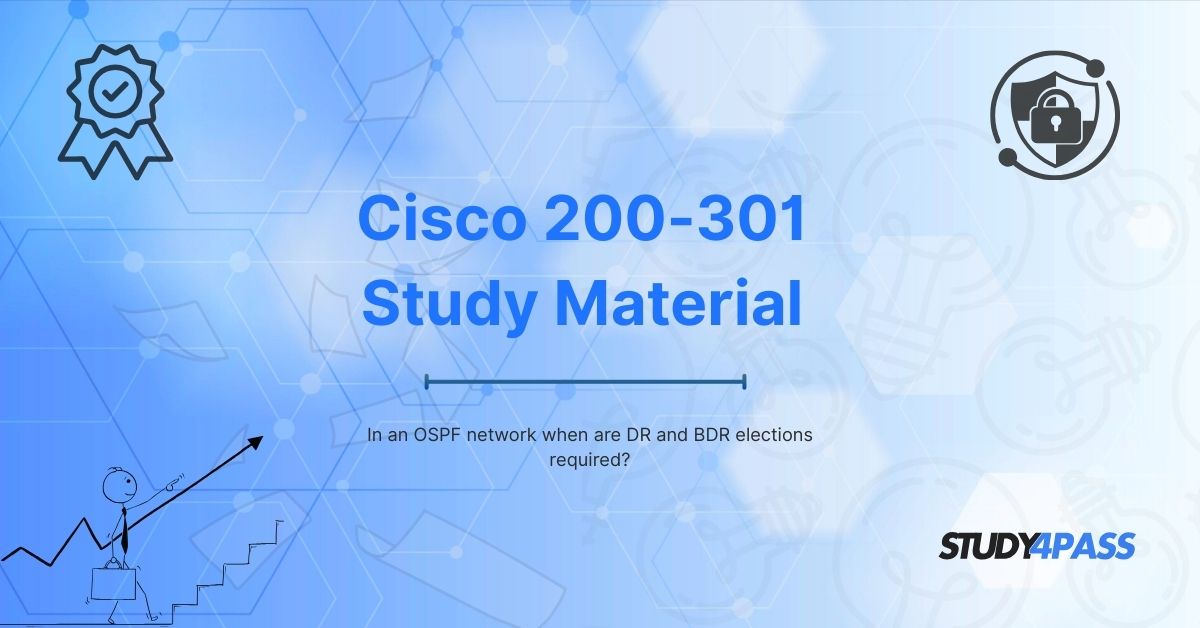Introduction
Open Shortest Path First (OSPF) is a widely used link-state routing protocol in IP networks. One of its key features is the election of a Designated Router (DR) and a Backup Designated Router (BDR) on multi-access networks. Understanding when and how these elections occur is crucial for network engineers preparing for certifications like CCNA, CCDA, CCENT, CCNA Security, and CCNA Wireless.
This article explores:
- The role of DR and BDR in OSPF
- When DR/BDR elections are required
- How elections are conducted
- Factors influencing DR/BDR selection
- Best practices for OSPF configuration
Additionally, for those preparing for Cisco exams, Study4Pass offers high-quality 200-301 study material, including practice tests and detailed guides to help you master OSPF and other networking concepts.
Understanding OSPF DR and BDR Roles
What is a Designated Router (DR)?
In OSPF, a Designated Router (DR) is elected to reduce the number of adjacencies formed on multi-access networks (like Ethernet). Instead of each router forming an adjacency with every other router, they only form adjacencies with the DR and BDR.
What is a Backup Designated Router (BDR)?
The Backup Designated Router (BDR) takes over if the DR fails. This ensures continuity in the OSPF network without requiring a new election immediately.
Why Are DR and BDR Needed?
- Reduces Network Overhead: Without DR/BDR, every router would form adjacencies with every other router, leading to excessive LSA (Link-State Advertisement) flooding.
- Improves Efficiency: The DR manages LSA distribution, optimizing network performance.
- Ensures Stability: The BDR ensures seamless operation if the DR fails.
When Are DR and BDR Elections Required?
DR and BDR elections occur in multi-access broadcast and non-broadcast networks where multiple OSPF routers share the same segment.
Scenarios Requiring DR/BDR Elections
- Initial OSPF Network Setup
- When OSPF is first enabled on a multi-access network, routers initiate an election process.
- If a new router with a higher priority or Router ID joins, it may trigger a re-election.
- If the DR fails, the BDR takes over, and a new BDR election occurs.
- If both DR and BDR fail, a new election is triggered.
- Restarting an OSPF interface can lead to a new election.
- Changing OSPF priority values or Router IDs can force a re-election.
Scenarios Where DR/BDR Elections Are NOT Required
- Point-to-Point Links: No DR/BDR is needed because only two routers communicate directly.
- Point-to-Multipoint Networks: These networks behave like multiple point-to-point links, eliminating the need for DR/BDR.
How DR and BDR Elections Work?
Election Process
- Router Priority:
- Each OSPF router has a priority value (0-255).
- Default priority = 1.
- Priority 0 = Router cannot become DR/BDR.
- If priorities are equal, the highest Router ID wins.
- Router ID is determined by:
- Manually configured ID
- Highest loopback IP
- Highest active interface IP
- Routers exchange Hello packets containing priority and Router ID.
- The router with the highest priority becomes DR.
- The second-highest becomes BDR.
- All others become Druthers’ (non-DR/BDR routers).
Non-Pre-emptive Elections
- Once elected, DR/BDR retains its role unless it fails.
- A new router with a higher priority does not trigger an immediate re-election.
Factors Influencing DR/BDR Selection
|
Factor |
Impact on Election |
|
OSPF Priority |
Higher priority wins. |
|
Router ID |
Higher ID breaks ties. |
|
Stability |
Existing DR/BDR remains unless down. |
|
Manual Config |
Can force a router to be DR/BDR. |
Changing OSPF Priority
To influence elections, adjust priority:
Router(config-if)# ip ospf priority <0-255>
Forcing a Reelection
- Shut down and re-enable the OSPF interface.
- Clear OSPF process (use with caution):
Router# clear ip ospf process
Best Practices for OSPF DR/BDR Configuration
- Manually Assign DR/BDR Roles
- Set priority values to ensure stable routers (e.g., core switches) become DR/BDR.
- Ensure critical routers can participate in elections.
- Provides a stable ID even if physical interfaces go down.
- Use commands like:
show ip ospf neighbor
show ip ospf interface
Study4Pass - Your Best Resource for Cisco Certifications
Preparing for CCNA, CCDA, CCENT, CCNA Security, or CCNA Wireless? Study4Pass provides:
- Latest 200-301 Study Material
- Real Exam Practice Questions
- Detailed OSPF Lab Guides
- Expert Explanations
Visit Study4Pass today and accelerate your networking career!
Conclusion
DR and BDR elections are essential in OSPF multi-access networks to optimize routing efficiency. Understanding when and how these elections occur is critical for network engineers, especially those pursuing Cisco certifications. By following best practices and leveraging resources like Study4Pass, you can master OSPF and excel in your networking career.
For more in-depth guides and exam preparation, check out Study4Pass—the ultimate platform for Cisco certification success!
Special Discount: Offer Valid For Limited Time “200-301 Study Material”
Actual Exam Questions For Cisco's 200-301 Practice.
Sample Questions For Cisco 200-301 Certification
1. In an OSPF network, DR and BDR elections are required on which type of network?
a) Point-to-Point
b) Broadcast
c) Non-broadcast multi-access (NBMA)
d) Point-to-Multipoint
2. What is the primary reason for DR and BDR elections in an OSPF network?
a) To reduce the number of OSPF packets
b) To elect a designated router for efficient routing
c) To increase network security
d) To ensure IP address allocation
3. Which OSPF network type does not require DR and BDR elections?
a) Broadcast
b) Non-broadcast
c) Point-to-Point
d) Broadcast multi-access
4. DR and BDR elections occur in OSPF when there are multiple routers connected on which type of network?
a) Non-broadcast multi-access
b) Point-to-Point
c) Point-to-Multipoint
d) Loopback
5. In an OSPF broadcast network, who is responsible for initiating the DR and BDR election process?
a) The router with the lowest OSPF priority
b) The router with the highest router ID
c) The router with the highest IP address
d) All routers in the network simultaneously


